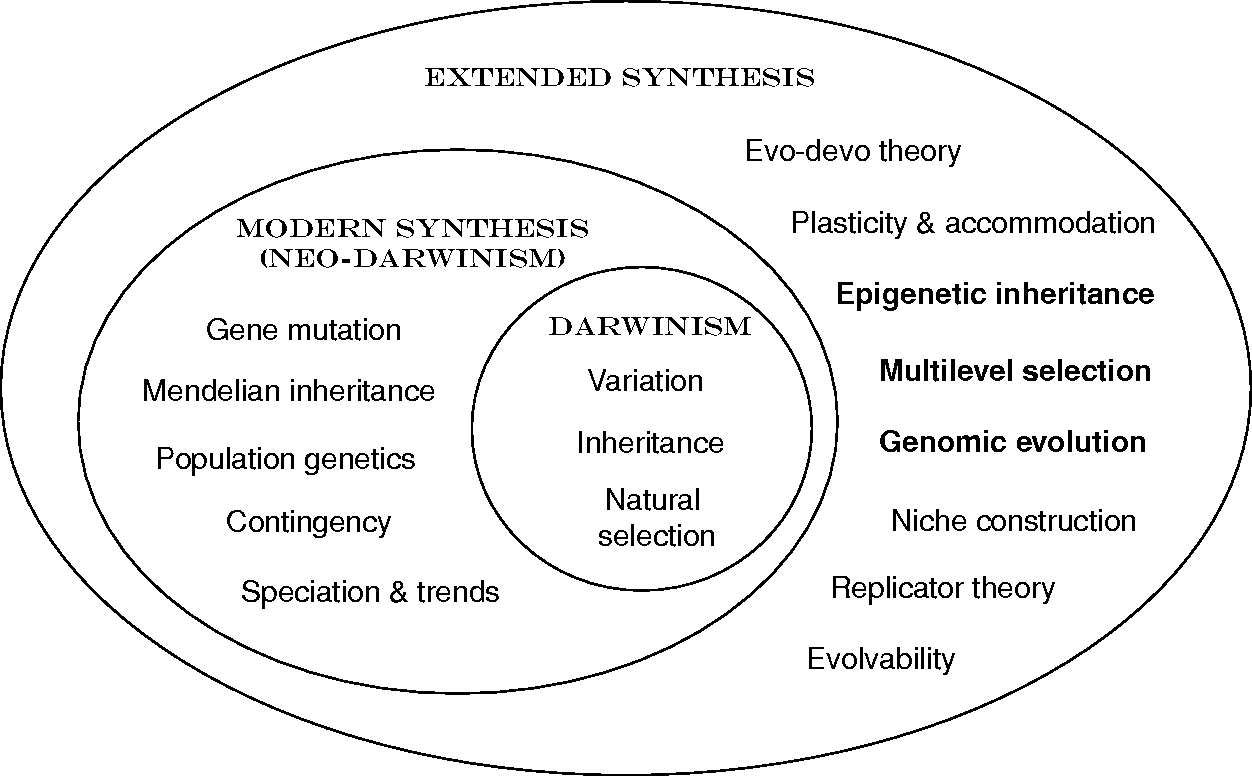What is Evolution-Deco?
Fisher’s Geomeric Model: A series of concentric spheres that sets a model for evolution of organisms with the optimal phenotypes at the center and an approach from the exterior.
What is a mechanism (in terms of Eco-Devo) ?: ???
“natural selection is an analytic consequence of the lives, deaths and reproduction of individuals”
Minimal Conditions for Evolution by Natural Selection: Richard Lewontin
- Phenotypic variation
- Fitness difference
- Inheritance
Darwinian General Principle by Elliott Sober: If thgere is heritable variation in fitness, then there will be evolution.
Source vs Consequence Rules:
- Source: Describe the circumstances that produce heritable fitness variations
- Consequence: Describe how hewritable variation in fitness, once it exists, leads to evolutionary differences.
The Representation Problem: “The process of adaptations can proceed only to the extent that favourable mutations occur, and this depends on how genetic variation maps onto phenotypic variation.”
Phylogenesis: Variation
Ontogenesis: Development
Waddington’s Epigentic Landscape: Creodes
Read: The Strategy of the Genes
Five Core Components of Population Genetics
- Mutations are random with respect to adaptation. Their role is to supply the genetic variation required for natural selection.
- Selection is the primary directional “force” in evolution (and is largely restricted to the indivisual level).
- Recombination occurs in sexually reproducting populations
- Isolation (a mechanism for preserving gene flow) causes speciation.
- Drift important in small enough populations. “It is the persistence of unfavourable mutations.”
Development not included: as long as there is some determinate relation between genes and phenotypes, development can be safely ignored.
“Whether or not adaptive changes can be produced depends critically on the genotype-phenotype map.”
A Basic Recipie for Mechanistic Explanations:
- Mechanistic Decomposition (empirical) +
- Dynamical Systems (suffcient)
Cis-regulatory elements: are regions of non-coding DNA which regulate the transcription of neighboring genes. CREs are vital components of genetic regulatory networks, which in turn control morphogenesis, the development of anatomy, and other aspects of embryonic development, studied in evolutionary developmental biology. (Wikipedia)
“You are not even wrong!” - Pauli
Extended Evolutionary Synthesis

- Four main problems with the Extended Synthesis
- It does not extend anything.
- It is not a synthesis at all. In fact, we don’t want a synthesis!
- It gets sort of close, but still misses the point in a rather fundamental way.
- It is not a theory in any meaningful sense of the word.
- Multi-modular approach is probably the key.
- Heritable variability must be reliably re-generated through ontogenesis during each generation.
- “Far rom being master molecules, genes are prisioners of development, locked in the deepest recesses of a hierarchy of prisions.”
Introduction to concepts in evo-devo
“High testorone men have a big chin. — evolutionary selection”
In an evolutionary model, a character is a system attribute which is mutable and
publicon a reasonable timescale. Constraint ispublicbut not mutable over a reasonable timescale.Exaptation: A character that was selected for one purpose, but gets used for another. Like wings, which could have evolved for body temperature regulation.
Developmental Plasticity: Key Concepts and Mechanisms
- Phenotypic observation is interferred by environmental cues.
- Polyphenism: Non-linear variation of phenotypes with Environemtnal changes.
- Temperature alters the effects of protein on wing size change.
- Evolution of plasticity reshapes animal morphology:
- Scaling relationship of organs with total body size
- To determine the size of the fly larvae, we need to know the:
- growth rate
- growth time (developmental period)
Evolution of phenotypic Plasticity - Part II
- Genetic variation in plasticity (GxE) is common.
- Genetic assimilation: The process by which a phenotype originally produced in response to an environmental stimulus, later becomes genetically fixed via selection.
Micro-evo-devo-eco
- Population Genetics: Studies allele frequerncy distribution oin populations that change due to evolutionary forces such as drift and selection.